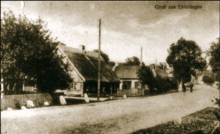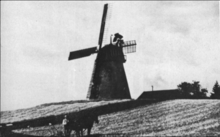Zielonka Pasłęcka
Zielonka Pasłęcka [ʑɛˈlɔnka paˈswɛnt͡ska] (German: Grünhagen) is a village in the administrative district of Gmina Pasłęk, within Elbląg County, Warmian-Masurian Voivodeship, in northern Poland.[1] It lies approximately 7 kilometres (4 mi) south of Pasłęk, 23 km (14 mi) south-east of Elbląg, and 58 km (36 mi) north-west of the regional capital Olsztyn.
Zielonka Pasłęcka | |
|---|---|
Village | |
| Grunehayn | |
 Zielonka Pasłęcka | |
| Coordinates: 53°59′43″N 19°41′55″E | |
| Country | |
| Voivodeship | Warmian-Masurian |
| County | Elbląg County |
| Gmina | Pasłęk |
| Population | 606 |
Before 1945 the area was part of Germany (East Prussia).
The village has a population of 606.
The village owns Kielminek and Wójtowizna.
History

The village was founded around 1483 by the commander Philip von Angelbach from Preußisch Holland. It suffered significant damage in 1658 during the march of the Swedish army, but quickly recovered from it. In the 18th century, many Poles were noted among the residents. In the first half of the 19th century a road to Preußisch Holland was built, in 1882 the village gained a railway connection with the station. In 1905, a post office was established, the post office operates here and now. Until 1945, production and service plants operated in Zielonka Pasłęcka, until 1934 there were two dairy plants (after that time there was one), there were two taverns (one ended its activity also in 1934). Gas stations, there were 6 carpenters, 4 tailors, 2 blacksmiths, the same number of carpenters, bakers, but there was also a butcher and watchmaker. There was a three-grade elementary school, agricultural school, and bookstore. Of the 787 residents, there were 22 Catholics next to the Protestants. In 1910, maneuvers of the Imperial Army took place in the area of the village. During World War II, there was a collective camp of forced labor, mainly Poles. The first Polish settlers came here from June to August 1945 from the territory of Volhynia. A school was opened, which received a new building in 1966, and a restaurant, the building of which was later taken over by the Peasant Cooperative. The building of one of the taverns was taken over to the Citizens' Militia station. The village got its current name after 1945. At the beginning of its existence it was referred to as Grunehayn, then until 1945 as Grünhagen.
Historical buildings and things

A baroque church from 1792, with an older tower, from 1778 (the temple has a decor dating back to the 15th century), a Dutch windmill from the 19th century, a former school building and two houses from the beginning of the 19th century.
Railroad Tragedy of January 1945
Near the end of World War II, on 21 and 22 January 1945 the village's train station was the site of a tragic train wreck followed by a Soviet attack on unarmed refugees. A German Army hospital train full of wounded which had stopped briefly at the station was rear-ended some time around 11 pm in the night by a train carrying a few thousand refugees from Osterode and Mohrungen. The collision resulted in many killed and wounded on both trains. A second refugee train arrived not long afterwards, but was able to come to a stop before colliding with the first refugee train.
The collision destroyed a number of rail cars on both the hospital and the refugee trains; this permanently blocked the way for the second refugee train. The hospital train, leaving its wrecked wagons behind, was able to proceed towards the west and escape towards Elbing and Preußisch Holland However, three to four thousand refugees were left waiting for a replacement train that never arrived.

At dawn on 22 January a Soviet Army unit consisting of tanks and infantry arrived, and, possibly due to the presence of some German soldiers in uniform, opened fired on the many people and buildings at the station, killing 140 to 150. The few German soldiers were taken prisoners, and a guard troop was set to make sure the refugees remained in place. These were removed after a week, whereupon the remaining people dispersed. The dead from both the train wreck and the Russian attack were buried in shallow graves in sites near the train station.[2]
References
- "Central Statistical Office (GUS) - TERYT (National Register of Territorial Land Apportionment Journal)" (in Polish). 2008-06-01.
- "Excerpt from Flight and Expulsion". 2014-11-30.
